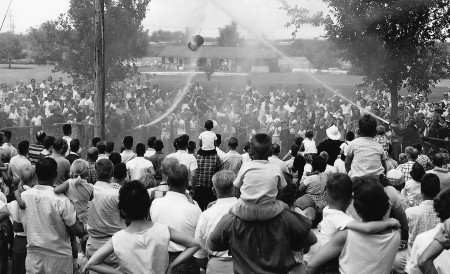
circ 1960: Here’s a blast from the past as Windsor Heights residents cool off with a water fight courtesy of the local fire department in 1960. Photo courtesy of the City of Windsor Heights
By Michael Swanger
This fall, as part of its 75th anniversary celebration, city leaders will place a historical marker in Windsor Heights to officially proclaim the central Iowa town as the middle of the region, further bolstering its slogan, “The heart of it all.”
Nestled between Des Moines and its western suburbs, Windsor Heights is centrally located in the metro. But its mayor says that there is a deeper meaning to “The heart of it all” when considering the town’s timeless amenities like its mid-century brick homes and unique small businesses, popular parks and community center, and its walkability and efforts for “green” sustainability.
“Our whole philosophy with our 75th anniversary is not just to celebrate 75 years, but we’re making landmark decisions to propel Windsor Heights for the next 75 years,” said Windsor Heights Mayor Diana Willits, who made history herself when she was elected in 2013 as the town’s first female mayor. “Our town was started by several business owners who were eclectic and wanted to create a safe, close-knit community for families with unique homes and businesses. Seventy-five years later, people are still attracted to that idea. We work hard to maintain the integrity of our neighborhoods and business climate and now we’re seeing more people my age, as well as more Millennials move here as a result.”
Long before Windsor Heights became home to about 5,000 people and more than 150 businesses, it was an area known for its coal mines. The Urbandale Coal Company Mine, Gibson Coal Mining Company Mine No. 5, the Keystone Coal Company Mine and Des Moines Ice and Fuel Company West Side Mine all operated in various stages from 1908 to 1942 in the area that is now known as Windsor Heights as coal miners and their families helped to settle the area.
A slow transformation began in 1915 when Charles H. Colby and his son, Charles I. Colby (the “I” stood for “Iowa”) bought 160 acres (reportedly at $300 per acre) that occupied two family farms in 1915. Two years later, they bought the West Side Coal Mine where the mouth of the mine’s shaft was located near where Wal-Mart and Sam’s Warehouse Club operate today.
“Papa got in the coal mining business in a rather strange way,” Charles I. Colby wrote for “Windsor Heights: 50th Anniversary History.” “A Des Moines real estate dealer named Harry Northrop for many years used to bring land deals to my father, and one spring day in 1914, I drove papa and Mr. Northrop in our Allen automobile way out west on University Avenue, almost to Dallas County, to look at the Mott farm. As the paving stopped at 49th Street, we stopped there and put on the tire chains and plowed into the nearly impassable yellow clay mud road.”
The city’s founding family was instrumental for paving University Avenue years later, which Charles I. Colby described as having “very steep, high hills and deep valleys at the time.” They saw to it that the main gateway to the city was paved from 49th to 63rd streets, then to the West Side Coal Mine’s entrance near 70th Street and University Avenue.
“It used to be called Colby Acres when we started dividing up the farm and selling lots, and then we incorporated and called the town Windsor Heights,” Clark A. Colby, the son of Charles I. Colby told the Des Moines Register in 1991.
The Colby’s influence can still be felt today. The family’s companies built several homes in the area, including many signature California-style ranch homes. Its name is also on commercial real estate projects like Sherwood Forest located on Hickman Road and the Apple Valley Shopping Center on University Avenue. The recently renovated Colby Park is home to the $1.5 million Windsor Heights Community and Events Center that opened in 2010, as well as a new baseball field, playground and pavilion where free concerts and movies play during the summer.
Windsor Heights was incorporated following a vote of 300 to 222 on July 19, 1941.
“It was a village, and they didn’t want to be annexed by Des Moines,” said George Hanusa, Windsor Heights’ unofficial historian who moved there in 1976 and is working on an updated history of the city to be published this summer. “They wanted to provide their own public services, but it was controversial at the time and the vote was close.”
The town took its name from the nearby Windsor Elementary School, which was named for early settler Henry Clay Windsor, whose family donated land for the school.
TO READ MORE ABOUT THIS STORY AND OTHER FASCINATING STORIES ABOUT IOWA HISTORY, subscribe to Iowa History Journal. You can also purchase back issues at the store.
